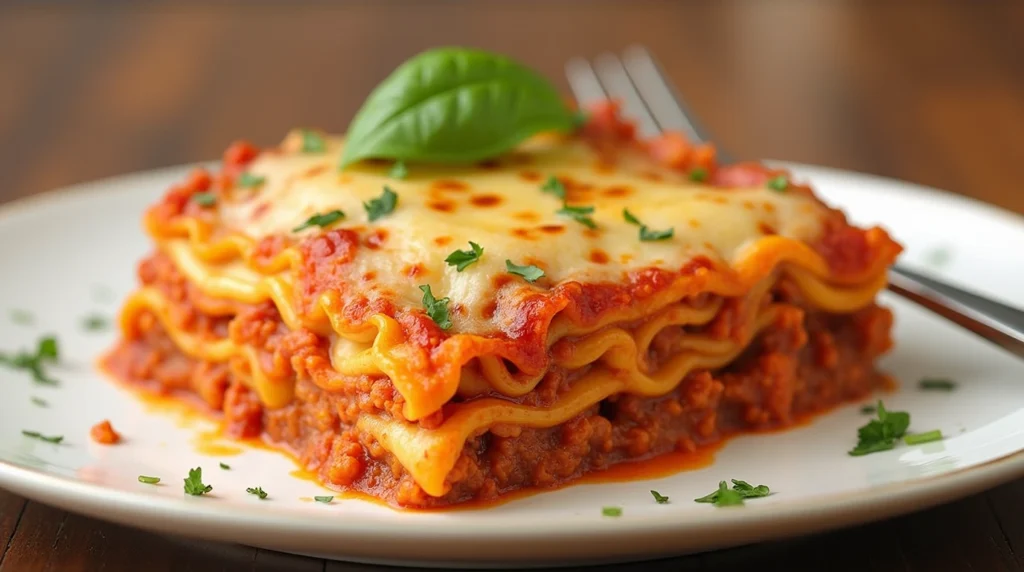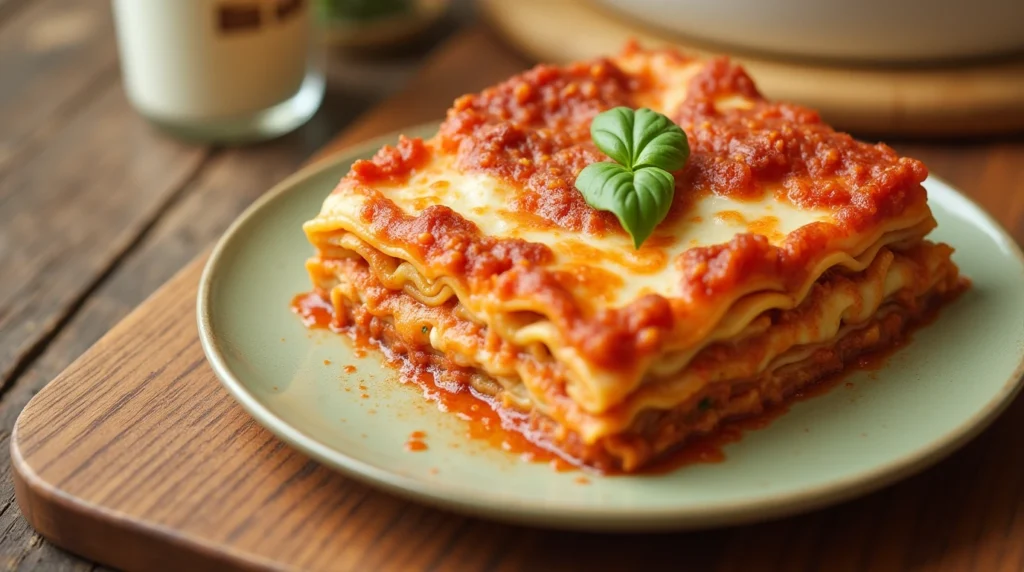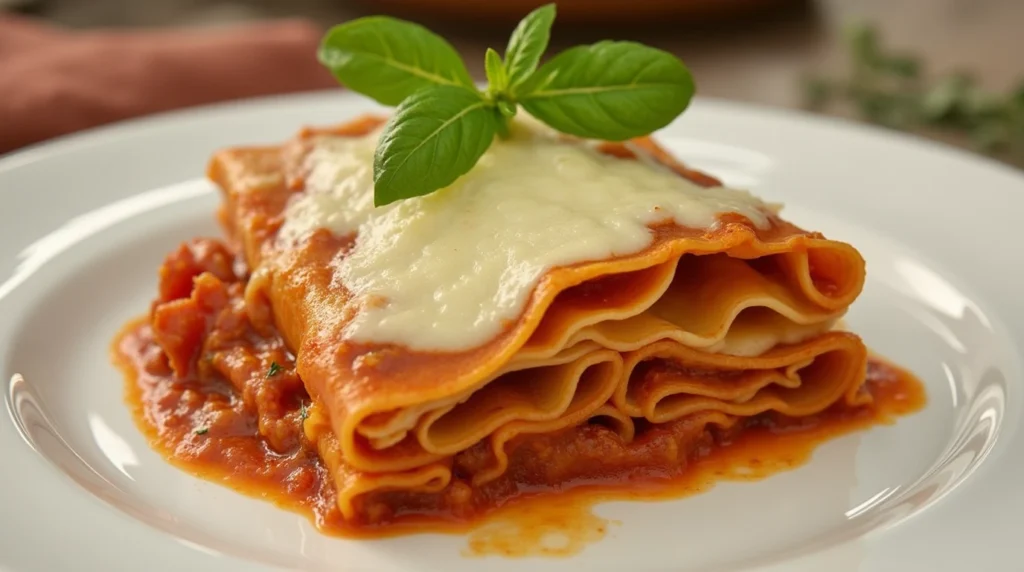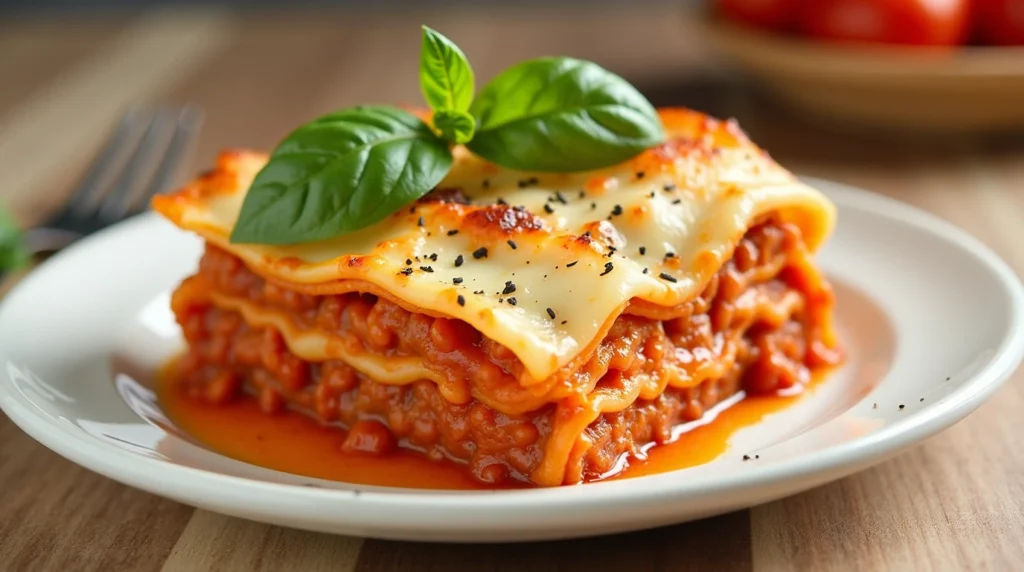1. The History and Tradition of Classic Italian Lasagna

The Origins of Lasagna in Italian Cuisine
Classic Italian Lasagna is more than just a dish—it’s a piece of Italian history. The Emilia-Romagna region, particularly the city of Bologna, is credited with giving birth to this iconic meal. The earliest versions of lasagna date back to the Middle Ages, where it was made with flat pasta sheets, local cheeses, and rich meat sauces. Over time, the recipe evolved, incorporating béchamel sauce and other regional ingredients.
Fun fact: The first recorded recipe for lasagna appeared in a 14th-century Italian cookbook, Liber de Coquina, which described a layered dish of pasta, cheese, and spices. This historical connection makes lasagna not just a meal but a culinary tradition passed down through generations.
What Makes a Lasagna Authentically Italian?
Authentic Classic Italian Lasagna is defined by its simplicity and respect for quality ingredients. Unlike some modern interpretations, traditional lasagna avoids heavy seasoning or overly complicated techniques. Instead, it focuses on:
- Fresh Ingredients: Ripe tomatoes, locally sourced meats, and handmade pasta.
- Time-Honored Techniques: Slow-simmered sauces and careful layering.
- Regional Variations: In Northern Italy, béchamel is favored, while Southern versions often use ricotta.
This commitment to tradition is what sets authentic lasagna apart from its global adaptations.
Why Classic Italian Lasagna is a Timeless Dish
Lasagna’s universal appeal lies in its ability to comfort and satisfy. It’s a dish that feels like a warm hug, perfect for family dinners, holidays, or even casual weeknight meals. Its layers symbolize the layers of love and care that go into making it, making it a staple in Italian households and beyond.
2. Essential Ingredients for Authentic Classic Italian Lasagna
The Perfect Bolognese Sauce
The Bolognese sauce, or ragù alla Bolognese, is the heart of your lasagna. Here’s how to make it unforgettable:
- Meat: Use a mix of ground beef and Italian sausage for depth of flavor.
- Vegetables: Sauté onions, garlic, and carrots until caramelized.
- Tomatoes: Opt for San Marzano tomatoes for their sweetness and low acidity.
- Wine: A splash of red wine adds richness and complexity.
- Simmering: Cook the sauce low and slow for at least 2 hours to meld the flavors.
Pro Tip: Add a splash of milk or cream to the sauce for a touch of sweetness and creaminess, a traditional Bolognese trick.
The Role of Béchamel Sauce
Béchamel, or besciamella, is the unsung hero of lasagna. It adds a creamy texture that balances the robust flavors of the Bolognese. To make it:
- Melt butter in a saucepan and whisk in flour to create a roux.
- Gradually add warm milk, whisking constantly to avoid lumps.
- Season with nutmeg, salt, and pepper for a subtle, aromatic flavor.
Choosing the Right Cheese
Cheese is what makes lasagna irresistibly gooey and flavorful. Here’s a breakdown of the best options:
- Ricotta: Adds creaminess and a slightly sweet flavor.
- Mozzarella: Provides that iconic stretchy, melty texture.
- Parmesan: Offers a nutty, salty finish that enhances the overall flavor.
Pro Tip: Use freshly grated Parmesan for the best flavor and texture.
Lasagna Noodles: Fresh vs. Dried
The type of noodles you use can make or break your lasagna. Here’s a comparison:
- Fresh Noodles: Offer a delicate, tender texture but require more effort to make or source.
- Dried Noodles: Convenient and widely available. No-boil varieties save time and work well in most recipes.
Recommendation: If you’re short on time, high-quality no-boil noodles are a great option.
3. Step-by-Step Guide to Making Classic Italian Lasagna
Preparing the Bolognese Sauce
- Heat olive oil in a large pot and sauté onions, garlic, and carrots until softened.
- Add ground beef and Italian sausage, breaking it up with a spoon as it browns.
- Stir in tomatoes, red wine, and seasonings. Bring to a simmer, then reduce the heat and cook for 2-3 hours, stirring occasionally.
Layering the Lasagna Like a Pro
- Start with a thin layer of Bolognese sauce at the bottom of your baking dish to prevent sticking.
- Add a layer of noodles, followed by Bolognese, béchamel, and a sprinkle of cheese.
- Repeat the layers, finishing with a generous topping of cheese for a golden, bubbly crust.
Pro Tip: Avoid overloading the layers with sauce, as this can make the lasagna soggy.
Baking Your Lasagna to Perfection
- Preheat your oven to 375°F (190°C).
- Cover the lasagna with foil and bake for 25 minutes to allow the flavors to meld.
- Remove the foil and bake for another 20 minutes, or until the top is golden and the edges are bubbling.
Pro Tip: Let the lasagna rest for 10-15 minutes before serving. This allows the layers to set and makes slicing easier.

4. Expert Tips for the Best Homemade Lasagna
How to Prevent Soggy Lasagna
- Pre-Cook Noodles: If using dried noodles, parboil them for a few minutes to remove excess starch.
- Drain Sauces Well: Ensure your Bolognese sauce isn’t too watery before layering.
- Use a Wire Rack: Place the baked lasagna on a wire rack to allow steam to escape and prevent sogginess.
Make-Ahead and Freezing Tips
- Make-Ahead: Assemble the lasagna up to a day in advance and refrigerate. Add 10-15 minutes to the baking time if cooking straight from the fridge.
- Freezing: Bake the lasagna until just set, then cool completely. Wrap tightly in foil and freeze for up to 3 months. Reheat in the oven at 350°F (175°C) until warmed through.
Customizing Your Lasagna
- Vegetarian Option: Replace the meat with sautéed mushrooms, spinach, or zucchini.
- Gluten-Free: Use gluten-free lasagna noodles and ensure all other ingredients are gluten-free.
- Spicy Twist: Add red pepper flakes or spicy Italian sausage for a kick.
Serving Suggestions for the Perfect Meal
- Garlic Bread: A classic pairing that’s perfect for soaking up extra sauce.
- Green Salad: A fresh, crisp salad balances the richness of the lasagna.
- Red Wine: A glass of Chianti or Sangiovese complements the flavors beautifully.
5. The Cultural Significance of Classic Italian Lasagna
Lasagna as a Symbol of Italian Hospitality
In Italy, food is more than sustenance—it’s a way of expressing love and hospitality. Lasagna, with its layers of care and attention, embodies this spirit. It’s a dish often prepared for special occasions, family gatherings, and holidays, symbolizing warmth and togetherness.
Regional Variations of Lasagna in Italy
While the Emilia-Romagna region is famous for its Bolognese-based lasagna, other regions have their own unique takes:
- Southern Italy: Uses ricotta instead of béchamel and often includes hard-boiled eggs and meatballs.
- Liguria: Incorporates pesto and vegetables for a lighter, herbaceous version.
- Sicily: Features layers of eggplant, tomatoes, and ricotta salata, reflecting the island’s Mediterranean influences.
These regional variations highlight the diversity of Italian cuisine and the adaptability of lasagna as a dish.
6. The Science Behind Perfect Lasagna Layers
Why Layering Matters
The beauty of lasagna lies in its layers, each contributing to the overall texture and flavor. Here’s how to achieve the perfect balance:
- Base Layer: A thin layer of sauce prevents the noodles from sticking to the dish.
- Noodles: Provide structure and absorb the flavors of the sauces.
- Sauces: Bolognese and béchamel add moisture and richness.
- Cheese: Melts into gooey perfection, binding the layers together.
The Role of Moisture Control
Too much moisture can make your lasagna soggy, while too little can leave it dry. Here’s how to strike the right balance:
- Sauce Consistency: Ensure your Bolognese is thick but not overly dry.
- Noodle Prep: If using dried noodles, parboil them slightly to absorb excess moisture.
- Resting Time: Let the lasagna rest after baking to allow the layers to set.
7. Pairing Classic Italian Lasagna with the Perfect Sides
Classic Italian Side Dishes
- Garlic Bread: A crispy, buttery accompaniment that’s perfect for mopping up sauce.
- Caprese Salad: Fresh tomatoes, mozzarella, and basil provide a light, refreshing contrast.
- Roasted Vegetables: Seasonal veggies like zucchini, bell peppers, and eggplant add color and nutrition.
8. Common Mistakes to Avoid When Making Lasagna
Overloading the Layers
Adding too much sauce or cheese can make the lasagna heavy and difficult to slice. Stick to thin, even layers for the best results.
Skipping the Resting Time
Cutting into lasagna straight out of the oven can cause it to fall apart. Let it rest for at least 10-15 minutes to allow the layers to set.
Using Low-Quality Ingredients
Lasagna is a dish that relies on the quality of its components. Opt for fresh, high-quality ingredients to elevate the final result.

9. Fun Facts About Classic Italian Lasagna
- World Record: The largest lasagna ever made weighed over 6,250 pounds and was created in Poland in 2012.
- Pop Culture Icon: Lasagna is famously loved by Garfield, the cartoon cat, who has helped popularize the dish worldwide.
- Versatility: Lasagna can be sweet or savory. In some parts of Italy, dessert lasagna is made with layers of pastry, fruit, and cream.
10. How to Store and Reheat Leftover Lasagna
Storing Leftovers
- Refrigerator: Store lasagna in an airtight container for up to 5 days.
- Freezer: Wrap individual portions tightly in foil or plastic wrap and freeze for up to 3 months.
Reheating Tips
- Oven: Reheat at 350°F (175°C) until warmed through. Cover with foil to prevent drying out.
- Microwave: Use a microwave-safe dish and cover with a damp paper towel to retain moisture.
- Stovetop: For small portions, reheat in a skillet over low heat, adding a splash of water or sauce to prevent sticking.
11. Lasagna Around the World
Global Adaptations of Lasagna
- United States: Often includes cottage cheese instead of ricotta and a heavier layer of mozzarella.
- Mexico: Features layers of tortillas, salsa, and cheese, known as pastel azteca.
- Greece: Similar to moussaka, with layers of eggplant, ground meat, and béchamel.
These adaptations showcase lasagna’s versatility and universal appeal.
12. A Quick Recipe for Classic Italian Lasagna
For those who want to dive right in, here’s a simplified recipe:
Ingredients
- 12 lasagna noodles (fresh or no-boil)
- 2 cups Bolognese sauce
- 2 cups béchamel sauce
- 1 ½ cups ricotta cheese
- 2 cups shredded mozzarella
- 1 cup grated Parmesan
Instructions
- Preheat the oven to 375°F (190°C).
- Spread a thin layer of Bolognese sauce in a baking dish.
- Add a layer of noodles, followed by Bolognese, béchamel, ricotta, mozzarella, and Parmesan.
- Repeat the layers, finishing with a generous topping of cheese.
- Bake for 25 minutes covered, then 20 minutes uncovered.
- Let rest for 10 minutes before serving.
13. Advanced Techniques for Perfecting Your Lasagna
Slow-Cooking the Bolognese Sauce
For an even deeper flavor, consider slow-cooking your Bolognese sauce. Here’s how:
- After browning the meat and adding the tomatoes, transfer the sauce to a slow cooker.
- Cook on low for 6-8 hours, allowing the flavors to meld and intensify.
- Stir occasionally and adjust seasoning as needed.
Pro Tip: Add a Parmesan rind to the sauce while it simmers for an extra layer of umami.
Homemade Pasta Sheets
If you’re feeling ambitious, making your own pasta sheets can take your lasagna to the next level. Here’s a quick guide:
- Combine 2 cups of flour and 3 eggs in a mixing bowl.
- Knead the dough for 10 minutes until smooth and elastic.
- Roll the dough into thin sheets using a pasta machine or rolling pin.
- Cut the sheets to fit your baking dish.
Homemade pasta adds a delicate texture and a sense of accomplishment to your dish.
Infusing Béchamel with Flavor
Elevate your béchamel sauce by infusing it with additional flavors:
- Herbs: Add a sprig of thyme or rosemary while heating the milk.
- Cheese: Stir in a handful of grated Parmesan or Pecorino Romano for extra richness.
- Spices: A pinch of nutmeg or white pepper adds warmth and complexity.
14. Creative Variations of Classic Italian Lasagna
Seafood Lasagna
For a coastal twist, replace the meat with a mix of shrimp, scallops, and crab. Use a white wine sauce instead of Bolognese and incorporate a light béchamel.
Vegetarian Lasagna
Swap the meat for roasted vegetables like eggplant, zucchini, and bell peppers. Add a layer of spinach or kale for extra nutrition.
Gluten-Free Lasagna
Use gluten-free lasagna noodles and ensure all other ingredients are gluten-free. You can also substitute zucchini or eggplant slices for the noodles.
Dessert Lasagna
Yes, dessert lasagna is a thing! Layer mascarpone cheese, fresh berries, and ladyfingers soaked in coffee or liqueur for a sweet treat.
15. The Role of Seasoning in Lasagna
Balancing Flavors
Lasagna is all about balance. Here’s how to season it perfectly:
- Salt: Enhances the natural flavors of the ingredients.
- Pepper: Adds a subtle heat and depth.
- Herbs: Basil, oregano, and thyme complement the tomato-based sauce.
- Spices: A pinch of red pepper flakes can add a hint of spice.
Pro Tip: Taste your sauces as you cook and adjust the seasoning gradually.
The Importance of Fresh Herbs
Fresh herbs can elevate your lasagna from good to great. Add chopped basil or parsley to the Bolognese sauce or sprinkle fresh herbs on top before serving for a burst of flavor and color.

Frequently Asked Questions About Classic Italian Lasagna
What’s the Difference Between Bolognese and Meat Sauce?
Bolognese is a slow-cooked sauce with a rich, complex flavor, while meat sauce is quicker and simpler. Bolognese typically includes milk or cream, which adds depth and richness.
Can I Use No-Boil Lasagna Noodles?
Yes, no-boil noodles are a convenient option. They absorb moisture from the sauces, so ensure your sauces are slightly thinner to prevent dryness.
How Long Does Lasagna Last in the Fridge?
Lasagna can be stored in the fridge for up to 5 days. Keep it covered to maintain freshness.
What’s the Best Way to Reheat Lasagna?
Reheat lasagna in the oven at 350°F (175°C) until warmed through. Cover with foil to prevent drying out. For smaller portions, use the microwave, but be sure to cover the dish to retain moisture.
Conclusion
Creating Authentic Classic Italian Lasagna at home is more than just cooking—it’s an experience that brings people together. From the rich history of its origins to the joy of sharing a homemade meal, lasagna is a dish that nourishes both the body and the soul. By following these tips and techniques, you’ll be able to craft a lasagna that’s not only delicious but also deeply satisfying.
So, gather your ingredients, roll up your sleeves, and get ready to impress your loved ones with the best homemade lasagna they’ve ever tasted. Don’t forget to share your results in the comments or on social media—we’d love to see your culinary creations!
